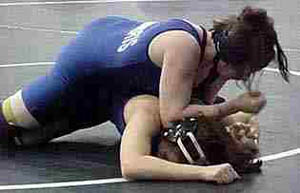 |
Women and Men in Society
Women in Sports:
Natural and Unnatural Challenges to Purity
Marian T. Horvat, Ph.D.
At about the same time the Olympics games started in Athens, it was announced that John Paul II had set up a Vatican department to encourage sports among the youth. I was quite disappointed to see in the item an unreserved encouragement of all sports – without a word of warning about modesty and the general Catholic decorum the Church has always taught, especially for women.


Above, Olympic Gold winner practicing gymnastics - still feminine but a sport with immodest clothing and indecent postures |
I am not an enthusiast of competitive sports for women. Prior to Vatican II, neither was the Catholic Church. It was always understood that the violent nature of many sports is incompatible with the feminine spirit. The demand for immodest sports dress, e.g. the swimsuit, acrobatics outfits, gym suits, etc., imposed on girls under the pretext of practicality, destroys their natural spirit of modesty.
But it is not only the dress that is objectionable, the positions and stances that girls and women assume are frequently prosaic and often clearly indecent. One need only consider the acrobatic routines of the 16-year-old American who won the all-around gymnast gold medal in Athens. The lithe young figure in leotards that reveal every line of her body has become a role model for a multitude of young girls, who will enroll in gymnastic classes and imitate her hairstyle, scanty outfits and poses without a thought about the immodest dress and indecent postures the sport dictates.
These girls are to be pitied because they lack serious moral guidance. Without such an orientation it is more or less inevitable that they should reach the a-moral (or immoral) level inherent to such sports today. The blame should not be laid principally on them, but on those who should have provided the direction. That is to say, the Conciliar Church. The silence of Church authority on the topic is disturbing. Before Vatican II, the Church was not mute on this important topic. It seems opportune to offer a few examples.
The perennial Church Morals
Pius XI issued a letter to the Cardinal Vicar of Rome expressing his disapproval of the impending national gymnastic and athletic competitions for women. The means employed to give health to the body, “the noble instrument of the soul,” he stated, should take into account suitability of time and place. They should not excite vanity or promote immodesty. And they must not lessen a young woman’s “reserve and self-possession which are both the ornament and guarantee of virtue” (Letter A Lei, Vicario Nostro, May 2, 1928).
Pope Pius XII, who watched the modern advance of immodest styles for women with concern, often reminded young girls to be vigilant against dangers threatening purity. He offered the exquisite delicacy of conscience of the martyr St. Perpetua as an example:
“When she was thrown into the air by a savage bull in the amphitheatre at Carthage, her first thought and action when she fell to the ground was to rearrange her dress to cover her thigh, because she was more concerned for modesty than pain” (Allocution to the girls of Catholic Action, October 6, 1940).
Mode and modesty should go hand in hand like two sisters, he continued, because both words derive from the Latin modus, meaning a right measure. He warned:
“Many women have forgotten Christian modesty because of vanity and ambition: they rush wretchedly into dangers that can spell death to their purity. They give in to the tyranny of fashion, be it even immodest, in such a way as to appear not even to suspect that it is unbecoming … They have lost the very concept of danger; they have lost the instinct of modesty” (ibid.).

Wearing small shorts has become common today, contrary to Catholic Morals. The blame should be put principally on the religious authorities that are silent
 |
One year later, congratulating the Catholic Action girls for beginning the “crusade for purity,” he encouraged a militant spirit against impurity. The life of man on earth remains always one of warfare, he said, and young women have a special fight against the dangers of immorality in the field of fashion and dress, and of health and sports. The weapons they must take up for the fight, Pius XII told them, are words, clothing and behavior that display a high standard.
It is truly a war, the Sovereign Pontiff warned. The purity of souls living in the state of supernatural grace is not preserved without a struggle. A special heroism is needed to counter public opinion, to stand apart from popular styles, amusements, and sports. This is even more difficult because of the “indulgent attitude, or better said, the negative attitude of an ever greater part of public opinion, which renders it blind to the gravest moral disorders ” (Allocution of May 22, 1941) .
He was quite specific on the things young women should shun at all costs:
• “Dresses which hardly suffice to cover the person;
• “Others that seem designed to emphasize what they should rather conceal;
• “Sports that are performed with such clothing;
• “The kind of exhibitionism that is irreconcilable with even the least demanding standard of modesty” (ibid.).
Some objections
* Pope Pius XII addressed the objection that was already being raised about the convenience of the new sports fashions. Some young women, he noted, offer practical objections, saying that “a certain form of dress is more convenient or even more hygienic.” This kind of protest is commonly heard today: “How can I do acrobatics in a dress? You can’t play soccer in a skirt,” and so on.

The violence of certain sports is contrary to the feminine spirit. Besides the immorality of the clothing, there is an action against nature.

|
How did Pope Pius XII respond? Quite simply but firmly, he stated,
“If a form of dress becomes a grave and proximate danger for the soul, it is certainly not hygienic for the spirit, and you must reject it” (ibid,).
Again, he turned to the example of martyrs to make his point. He challenged young girls to follow the example of girls like St. Agnes and St. Cecilia, who suffered tortures of body to preserve their virginal innocence and save their souls:
“Will you, then, for the love of Christ, in the esteem for virtue, not find at the bottom of your hearts the courage and strength to sacrifice a little well-being – a physical advantage, if you will – to conserve safe and pure the life of your souls?” (ibid.).
What is more, he added, if one does not have the right to endanger the physical health of others simply for one’s own pleasure, then it is certainly even less licit to compromise the health of their souls.
* With this, the Pontiff turned to another objection, also commonly heard today: that the immodest popular fashions do not cause young women any moral harm or lead them to make any personal compromises with purity. He answered:
“But how can you know anything of the impression made on others? Who can assure you that others do not draw therefrom incentives to evil? You do not know the depths of human frailty …. Oh, how truly was it said that if some Christian women could only suspect the temptations and falls they cause in others with modes of dress and familiarity in behavior, which they unthinkingly consider as of no importance, they would be shocked by the responsibility which is theirs” (ibid.).
* Pius XII added a strong word of warning to Catholic mothers who imprudently allow their sons and daughters to become accustomed “to live barely attired.” The relevance of his words make them well worth repeating for the benefit of both mothers and fathers today, many who are well meaning but ignorant of the dangers of the immodest clothing that has become commonplace today. He affirmed forcefully:
“O Christian mothers, if you only knew what a future of worries, dangers, and shame … you lay up for your sons and your daughters by imprudently accustoming them to live barely attired, making them lose the natural sense of modesty. You would blush and take fright were you to know the shame you inflict upon yourselves and the harm which you occasion to your children, entrusted to you by Heaven to be brought up in a Christian manner” (ibid.)
There is something yet more reprehensible, he continued, and that is for the mothers themselves and other women among the faithful - “and pious women at that” - to show approval of immodest fashions by wearing them themselves. The moment a “questionable fashion” appears on persons “beyond all reproach,” he warned, others will no longer hesitate to follow the current, “a current that will perhaps drag them to the worst falls” (ibid.).
Finally, Pius XII encouraged Catholic girls and mothers to join together to make a common effort to counter such fashions in dress, behavior and entertainment. Unity is strength, and even a small group of “resolute and not timid Christian spirits” can exert a strong influence and make a powerful moral example” (ibid.).
This is the moral teaching of the Holy Catholic Church that seems to have been forgotten by the very religious authorities that should emphasize them. Certainly, the dangers previous Popes so prudently warned about have not lessened, but rather augmented. The fashions have become bolder; complacency toward immodesty has grown; more girls and women are engaging in violent sports, even wrestling and football; manly and indecent language, postures and attitudes permeate much of the sports environment.
Everything speaks of a need for a renewed challenge of a “crusade for purity” to young women who engage in sports.
Increasingly masculine girls
Popes Pius XI and Pius XII were addressing an age-old problem, a badly governed feminine spirit that tempts men with immodest clothing and bold attitudes. Consciously or unconsciously seductive, these women at least remain feminine, and their censurable position is still a natural one. Today a new long step has been taken down the stairs of decadence: the emergence of the masculine girl.

A masculine young woman ... or a feminine young man?
LA Times, August 22, 2004 |
The new model is a strange androgynous figure. “Baller girls” is what some of the modern young athletes call themselves: girls who live for basketball, baseball, soccer, football – for the game, the sport, not for the skills and virtues that will help them as future wives and mothers. They are rough, sassy girls with the muscles of men, good enough to play against the “guys,” girls who have traded in their femininity in their mania for sports.
Look, for example, at the picture at left. Is the figure in it a he or a she? One doesn’t really know at first glance if the basketball player is a masculine girl or a feminine young man.
It is, in fact, a young woman, a popular college basketball player who represented the US at the Olympics. For some young girls aspiring to be athletes, she has become a new model ideal.
She is an icon for the “baller girls” in-the-making who surround her in the picture at right. They wear their baggy t-shirt and shorts not just on the court, but at home, at school, in the malls, even to church. They slick back their hair tight, no curls, bows and fancy barrettes for them. They shuffle everywhere in tennis shoes and socks. This kind of behavior represents a trend toward the ever more masculine girl. Such women seem to have taken a step past the loss of the instinct of modesty that Pope Pius XII warned against, they are losing the very instinct of femininity.
One can only wonder about the harsh and unhappy future of girls who reject their femininity openly and blatantly. They clearly have lost the notion of the dignity of the woman in view of her most noble office as wife, mother and helpmate of man. The masculine woman does not reflect a true emancipation. It is rather the debasing of the feminine character, a rejection of the wise plan of God. It is a position against nature.
Health of soul takes precedence over health of body
Catholic Morals are not like styles, they do not change with the times. What was immodest or indecent yesterday has not miraculously become acceptable today because of the omission or the complacence of the Conciliar Church. The words of Pope Pius XII to girls and women continue to be appropriate today:
“Beyond fashion and its demands, there are higher and more pressing laws, principles superior to fashion, and unchangeable, which under no circumstances can be sacrificed to the whim of pleasure or fancy, and before which must bow the fleeting omnipotence of fashion. These principles have been proclaimed by God, by the Church, by the Saints, by reason, by Christian morality…
"As St. Thomas of Aquinas teaches, the good of our soul must take precedence over that of our body, and to the good of our body we must prefer the good of the soul of our neighbor” (Allocution to the girls of Catholic Action of May 22, 1941).
There is only one way, today, as yesterday and tomorrow, for the Catholic girl and woman to counter immodesty in immoral fashions, bad language, and masculine attitudes: an absolute rejection of them. For the good of the soul, certain gymnastic exercises and sports are simply not suitable for Catholic young ladies.

Posted August 31, 2004

Related Works of Interest
|
|
Women and Men | Cultural | Home | Books | CDs | Search | Contact Us | Donate

© 2002- Tradition in Action, Inc. All Rights Reserved
|
 |
|